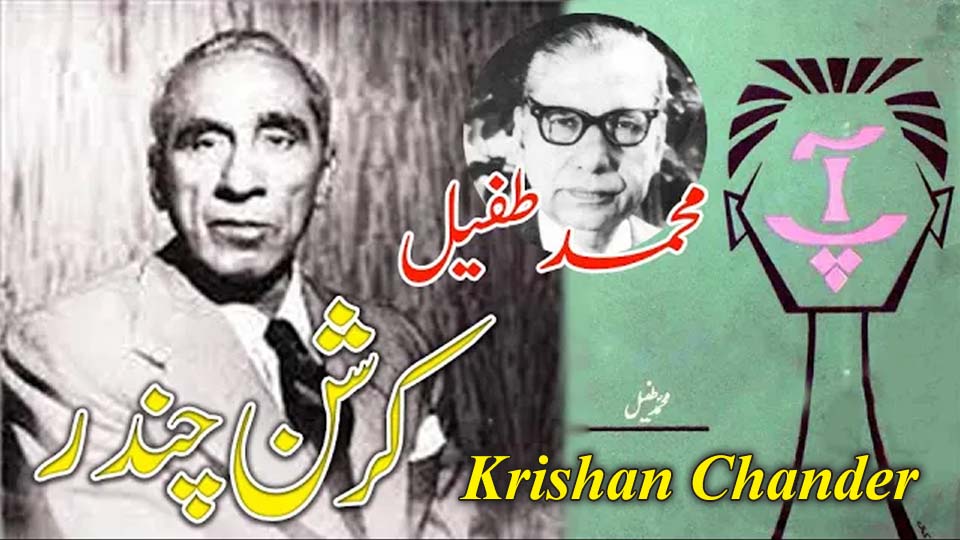Krishan Chander is a towering figure in the history of Urdu short stories. Whenever the canon of classical Urdu fiction is revisited, his name emerges as a symbol of creative excellence and emotional depth. But beyond his fiction, there exists a lesser-known yet profoundly moving portrait of him, written not by a casual observer, but by one of Urdu literature’s most refined sketch writers: Mohammad Tufail.
This blog explores the emotionally rich and artistically layered sketch of Krishan Chander included in Mohammad Tufail’s landmark book, Aap. The sketch doesn’t merely narrate facts; it revives the cultural soul and emotional intimacy shared between two literary giants. Through this, Krishan Chander becomes more than just a name in literary history—he becomes a human being etched in memory.
Mohammad Tufail: The Mind Behind the Masterpiece
Mohammad Tufail was not just a prose writer; he was a cultural chronicler, a literary psychologist, and the founder-editor of the renowned literary magazine Naqoosh. His sketches, or khake, were not superficial snapshots. They delved deep into the psychological, intellectual, and emotional dimensions of his subjects.
In 1967, he published Aap, a collection of four compelling sketches on renowned writers: Niaz Fatehpuri, Josh Malihabadi, Akhtar Orainvi, and most memorably, Krishan Chander. Rather than offering a linear biography, Tufail’s portrayal of Krishan is a profound meditation on creativity, friendship, nostalgia, and the human condition.
The Letter that Opened a Door
The sketch opens with a deeply personal letter written by Krishan Chander in 1951 to Mohammad Tufail. This letter sets the tone for the emotional depth that follows, showcasing their literary camaraderie and personal warmth. Tufail recalls seeing Krishan Chander for the first and last time in 1961—an encounter so rich in meaning that he laments not having captured every moment in writing.
Not Just a Writer, But a Presence
Tufail confesses that he first fell in love with Krishan Chander’s art and only then with his personality. He recalls reading the short story Zindagi ke Mor Par, which drew him into a world where fiction transcends plot and characters, transforming into lived experiences. For him, Krishan’s stories were not mere literature; they were life itself.
A Dinner of Words and Ideas
One of the most charming moments in the sketch is when Tufail visits Delhi, and Krishan Chander hosts him with lavish hospitality. With wit and warmth, Krishan remarks, “To love first class, you must eat first class too!” He not only served meals but also shared drafts of his latest story, asking for Tufail’s opinion on two different endings. Accepting Tufail’s critique and later altering his sketches accordingly, Krishan demonstrated his creative humility and integrity.
A Portrait Full of Emotion
In this Krishan Chander sketch, we see his emotional temperament, his longing for Lahore, and his deeply affectionate conversations with Tufail. It’s like walking through a gallery where each brushstroke is filled with feeling. Tufail not only paints a literary figure but also a man who is passionate, humorous, sensitive, and deeply human.
A Sketch Returned with Love
The beauty of this literary exchange is that Krishan Chander, in return, wrote a sketch of Mohammad Tufail, full of humor and affection. He described Tufail as a saint at first glance, a timber merchant in the second, a child at a third—and there was no fourth glance, for by then they were already in a warm embrace.
A Literary Relationship Immortalized
Through this emotional sketch, Krishan Chander and Mohammad Tufail appear not just as writers and subjects, but as soulmates bound by their love for literature. Aap is more than just a collection of profiles; it is a window into an era of Urdu literature brimming with dreams, flaws, brilliance, and beauty. It captures not only the spirit of its time but the timelessness of literary connection.
Preserving the Legacy with Voice
AwazeUrdu has breathed new life into this legacy by presenting excerpts of this sketch in audio format. The performance brings out the depth, humor, and literary richness that Krishan Chander embodied—and that Mohammad Tufail so delicately preserved.
Conclusion: The Timeless Echo
Krishan Chander, as portrayed in Mohammad Tufail’s sketch, becomes not just a storyteller, but a living story himself. His legacy continues to echo through literature, recordings, and reflections like this one. In celebrating this sketch, we celebrate a literary friendship that redefined what it means to write not just about someone, but for them.
If you’re interested in reading this book, click the link below for a free download.
https://drive.google.com/file/d/1yw8VhRZlQ8hDBQHcM-eNr3Z7TSIzESgy/view?usp=sharing
If you’d like to listen to this book in audio format, click the CONTACT button below to get in touch with the AwazeUrdu team to order the audiobook.
You can also watch the same video on these social media platforms.
اردو کے کلاسیکی افسانے کی تاریخ جب لکھی جائے گی تو کرشن چندر کا نام ہمیشہ اولین صف میں نمایاں رہے گا۔ وہ افسانہ نگاری میں نہ صرف طرزِاحساس بلکہ طرزِ اظہار کے نئے در وا کرنے والے تخلیق کار تھے۔ اُدھر اردو خاکہ نگاری کی بات کی جائے تو محمد طفیل کو وہ مقام حاصل ہے جو اس صنف کو ایک سنجیدہ، فکری اور فنکارانہ وقار عطا کرتا ہے۔ ان کی کتاب “آپ” نہ صرف اردو خاکے کا ایک اہم سنگِ میل ہے بلکہ اس میں کرشن چندر جیسے بڑے افسانہ نگار پر تحریر کردہ خاکہ اردو ادب میں ایک نادر امتزاج کی مثال بھی بن گیا ہے۔
محمد طفیل اردو ادب کے ممتاز نثر نگار، فکری صحافی اور ماہنامہ نقوش کے بانی و مدیر تھے۔ ان کی شخصیت ادب اور صحافت میں علمی و تخلیقی اعتبار سے ایک مضبوط حوالہ سمجھی جاتی ہے۔ ان کے ہاں خاکہ نگاری محض کسی شخصیت کی دلچسپ جھلک پیش کرنے کا نام نہیں بلکہ وہ شخصیات کے باطن، فکری ارتقا اور انسانی کرب کو ادبی اسلوب میں قید کرتے ہیں۔ ان کی تحریریں گہرے مشاہدے، نفسیاتی بصیرت اور سنجیدہ مزاح سے مزین ہوتی ہیں۔
محمد طفیل کےتحریرکردہ چار خاکوں کامجموعہ”آپ” 1967ء میں منظرِ عام پر آیا، جس میں چار بڑے ادیبوں — نیاز فتح پوری، جوش ملیح آبادی، اختر اورینوی اور کرشن چندر پر خاکے شامل ہیں۔ یہ خاکے سوانحی معلومات سے زیادہ فکری، نفسیاتی اور تخلیقی پہلوؤں کا مطالعہ ہیں۔ ان خاکوں میں محمد طفیل نے نہ صرف ان شخصیات کی ادبی خدمات کو اُجاگر کیا بلکہ ان کی انسانی کمزوریوں کو بھی ایمانداری اور لطیف طنز کے ساتھ پیش کیا ہے۔ “آپ” کو اردو خاکہ نگاری میں ایک اہم کتاب تسلیم کیا جاتا ہے، جو اپنے عہد کے ادبی، تہذیبی اور تخلیقی ماحول کی جھلک بھی پیش کرتی ہے۔
کتاب “آپ” میں شامل کرشن چندر پر لکھا گیا خاکہ نہ صرف ایک بڑے ادیب کا ترسیمہ ہے بلکہ ایک تہذیبی و فکری رشتہ کی کہانی بھی ہے۔ آوازِ اردو نے اس خاکے کا ایک اقتباس اپنی ویڈیو میں شامل کیا ہے، جو محمد طفیل کے جذبات، مشاہدے اور اندازِ بیان کا خوبصورت مظہر ہے۔
خاکہ کرشن چندر کے خط سے شروع ہوتا ہے جو انہوں نے 1951ء میں محمد طفیل کو لکھا تھا۔ اس میں ان کے باہمی تعلقات کی پختگی، ادبی رفاقت اور گہرے جذبات جھلکتے ہیں۔ طفیل لکھتے ہیں کہ کرشن چندر کو پہلی مرتبہ 1961ء میں دیکھا، اور اگر اندازہ ہوتا کہ وہ ملاقات آخری ہوگی، تو ہر لمحہ تحریر میں قید کر لیتے۔
محمد طفیل کا بیان ہے کہ انہوں نے کرشن چندر کے فن سے عشق کیا، پھر ان کی شخصیت سے۔ ان کا پہلا افسانہ “زندگی کے موڑ پر” پڑھ کر وہ اس دنیا میں داخل ہوئے جہاں افسانے کرداروں سے نہیں بلکہ زندہ انسانوں سے ملاقات کراتے ہیں۔ کرشن چندر کے افسانے ان کے لیے محض ادب نہیں بلکہ زندگی کے تجربات کا بیان بن گئے۔
خاکہ بتاتا ہے کہ جب محمد طفیل دہلی گئے تو کرشن چندر نے ان کی بڑی خاطر تواضع کی، عمدہ کھانوں سے مہمان نوازی کی، اور یہاں تک کہا کہ “فرسٹ کلاس عشق کرنے کے لیے فرسٹ کلاس کھانے کی بھی ضرورت ہے!” پھر کرشن چندر نے انہیں اپنا افسانہ بھی سنایا، اور اس کے دو ممکنہ اختتام سنا کر رائے طلب کی۔ محمد طفیل کی رائے سے اتفاق کرنا، اور بعد ازاں اُن کے اعتراضات کی روشنی میں اپنے اسکیچوں میں تبدیلی کرنا، کرشن چندر کی فنی دیانت اور عاجزی کا اظہار ہے۔
اس خاکے میں کرشن چندر کا جذباتی مزاج، لاہور کی یادیں، اور محمد طفیل کے ساتھ ان کی پرخلوص گفتگو — سب کچھ ایک دلکش ادبی تصویری نمائش کی طرح سامنے آتا ہے۔ آخر میں، کرشن چندر نے محمد طفیل پر خود بھی ایک خاکہ لکھا، جو نہایت محبت اور مزاح سے لبریز تھا — “پہلی نظر میں سجادہ نشین، دوسری میں لکڑیوں کے مال کے مالک، تیسری میں ایک معصوم بچہ، اور چوتھی نظر کا موقع ہی نہ ملا کیونکہ وہ بغلگیر ہو چکے تھے۔”
محمد طفیل اور کرشن چندر — دو مختلف اصناف کے نمایاں ادیب — اس خاکے کے ذریعے ایک خوبصورت ادبی رشتے میں بندھے نظر آتے ہیں۔ ایک طرف کرشن چندر کی تخلیقی عظمت اور انسانی اپنائیت ہے، دوسری طرف محمد طفیل کی گہری نظر، نفسیاتی بصیرت اور ہنر مند خاکہ نگاری۔ کتاب “آپ” صرف چار ادیبوں کا خاکہ نہیں، بلکہ اردو ادب کی ایک پوری نسل، اس کے خواب، جذبات، کمزوریاں اور عظمتوں کی جھلک ہے۔ آوازِ اردو نے اس ورثے کو زندہ رکھنے میں جو کردار ادا کیا ہے، وہ قابلِ تحسین ہے۔

